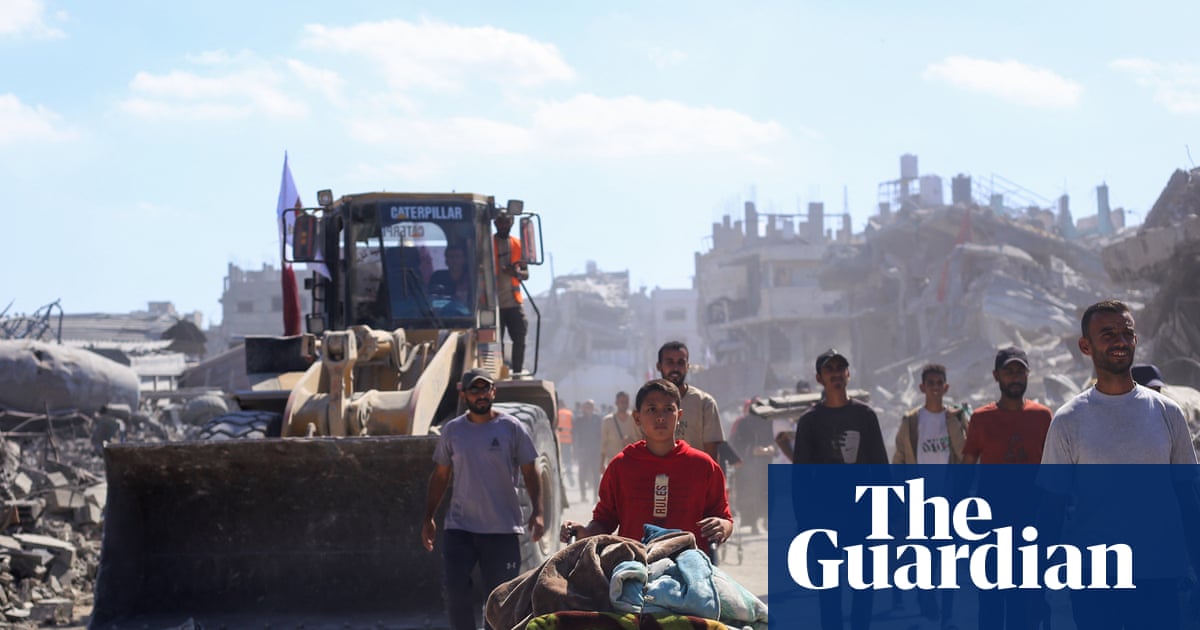Israel and Hamas trade blame over truce violations as tensions rise over return of hostage bodies
Militant group says it needs specialist equipment to recover remains as Netanyahu warns the fight ‘is not over’ Palestinian leader Marwan Barghouti assaulted by Israeli prison guards, son says Israel and Hamas have traded accusations of violating the ceasefire in Gaza amid tensions over the flow of aid into the devastated territory, the return of the remains of deceased hostages by the militant group and new casualties from Israeli firing on Palestinians close to new military positions. Regional diplomats and US officials have sought to minimise the significance of the accusations, emphasising that Hamas or Israel still appeared committed to the ceasefire agreed last week. Benjamin Netanyahu, Israel’s prime minister, said on Thursday that he was determined to ensure that Hamas handed back the remains of hostages still in Gaza, adding that the fight “is not over yet”. Speaking at a state ceremony for fallen soldiers during the two-year conflict, Netanyahu said Israel would achieve all its war aims and that its enemies had “learned that anyone who lifts a hand against it will pay a heavy price”. Under a ceasefire agreement, Hamas returned the last 20 surviving hostages to Israel but has handed back only nine of 28 deceased captives, saying it would need specialist recovery equipment to retrieve the rest from the ruins of Gaza. Israeli officials reject the claim, accusing Hamas of breaching the ceasefire agreement, though US advisers working on the implementation of President Donald Trump’s ceasefire deal and the Red Cross have said practical difficulties of recovering remains of hostages amid the devastation caused by Israel’s offensive during the 24-month war were significant. A senior Hamas official accused Israel of breaking the ceasefire by having killed at least 24 people in shootings since Friday, and said a list of such violations was handed over to mediators. “The occupying state is working day and night to undermine the agreement through its violations on the ground,” he said. The Israeli military did not immediately respond but has previously said some Palestinians have ignored warnings not to approach Israeli ceasefire positions and troops “opened fire to remove the threat.” Palestinian medical officials reported that a civilian had been killed in a drone strike near Khan Younis, in the south of Gaza. An Israeli military spokesperson denied any drone strikes in or around the city on Thursday. Israeli officials also said the Rafah crossing from Gaza into Egypt, which aid agencies consider critical for bringing sufficient humanitarian assistance into the territory, would open at “a later stage” and not on Thursday as planned. A spokesperson for Cogat, the Israeli defence ministry body that oversees civil affairs in the Palestinian territories, suggested too that Rafah would remain closed to aid in the future, although individual passage would be allowed. “It should be emphasised that humanitarian aid will not pass through the Rafah crossing. This was never agreed upon at any stage,” it said, adding that aid continues to enter the Gaza Strip through other crossings. Trump’s 20-point plan includes “full aid” reaching Gaza, where a famine was declared in some areas in August, as well as the return of all the hostages, dead and alive. Aid workers in Gaza said Israel’s restrictions on aid, apparently to pressure Hamas, amounted to “collective punishment”. Regional officials have told the Guardian they expected the first days and weeks of the ceasefire agreed by Hamas and Israel to be “tense” and “scratchy”, with aid and the return of the remains of hostages among key issues. Much of Trump’s plan, including many of the most difficult issues, has yet to be fully discussed by negotiating teams. Since Monday, under a ceasefire agreement brokered by the US president, Hamas released 20 surviving hostages in exchange for nearly 2,000 Palestinian prisoners and detainees freed from Israeli jails. This figure includes 1,700 Palestinians who were seized from Gaza during the war and held without charge. A senior US adviser told reporters late on Wednesday that retrieving the bodies from Gaza was difficult because the territory had been “pulverised”. Turkey, one of the key mediators in the deal, said it has deployed dozens of disaster relief experts to search for the remains of hostages still missing. On Thursday, a Turkish defence ministry source said “there is already a team of 81 AFAD staff there”, referring to Turkey’s disaster relief agency, indicating that “one team will be in charge of seeking and finding the bodies”. The ceasefire deal also requires Israel to return the bodies of 360 Palestinians. Gaza health ministry says it has received 30 more bodies of Palestinians from Thursday, bringing the total to 120 since last Friday. Doctors at Nasser hospital said the bodies showed signs of torture and execution, including blindfolds, cuffed hands and bullet wounds in the head, according to doctors’ accounts. “Almost all of them had been blindfolded, and had been bound up, and they had gunshots between the eyes. Almost all of them had been executed,” said Dr Ahmed al-Farra, the head of Nasser hospital’s paediatric department in Khan Younis. Trump has said he would consider allowing Israeli forces to resume fighting in Gaza if Hamas failed to uphold its end of the ceasefire deal. “Israel will return to those streets as soon as I say the word. If Israel could go in and knock the crap of them, they’d do that,” the US president was quoted on Wednesday as saying to CNN in a brief telephone call when asked what would happen if Hamas refused to disarm. The remains of the two hostages whose bodies were returned to Israel on Wednesday evening by Hamas have been identified as Inbar Hayman and Mohammad al-Atrash. Hayman, a graffiti artist from Haifa, was 27 when she was killed at the Nova music festival and her remains taken to Gaza. The body of Sgt Maj Atrash, a 39-year-old soldier of Bedouin origin who was killed in combat on 7 October, were also taken to the Palestinian territory. Analysts said that at least some of the hardline rhetoric from Israeli officials was aimed at political rivals in Israel, where an election was due within a year but likely to be held earlier. Israel’s far-right national security minister, Itamar Ben-Gvir, an opponent of the ceasefire plan, said on X that the aid delivery was a “disgrace” and accused Hamas of lies over the return of hostages’ bodies. Meanwhile, Hamas has launched a security crackdown in urban areas vacated by Israeli forces, parading its power through public executions and clashes with local armed clans. A Hamas political official, quoted by the Associated Press, has defended the execution-style killings of alleged gang members carried out by militants in Gaza since the ceasefire took effect. “The people who were targeted caused death and corruption in Gaza and killed displaced persons and aid seekers, and more dangerous than that, they represented the origin and foundation of Israel’s Zionist project,” said Hamas political representative in Lebanon, Ahmed Abdul Hadi, regarding the men who were publicly killed. “This was done by a Palestinian national and tribal consensus,” he said. Israel has also said that the next phase of the truce calls for Hamas to disarm and cede power, which it has so far refused to do. The group has launched a security crackdown, demonstrating its power in Gaza through public executions and clashes with local clans.



